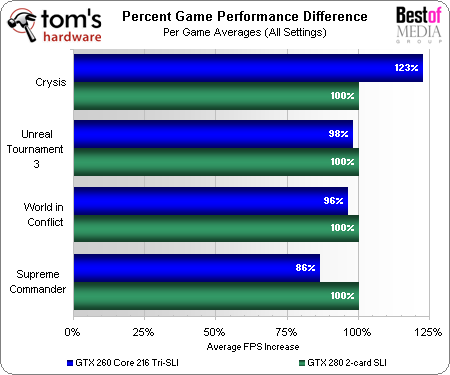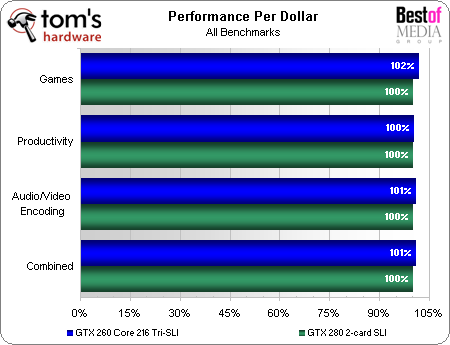Value In SLI? GTX 260 Core 216 Vs. GTX 280
Conclusion
We selected a 3-way GTX 260 Core 216 graphics solution for our $2,500 PC with hopes of greater gaming performance, particularly in Crysis, at a lower price. Let’s take a quick look at the overall gaming performance difference before considering value.

Crysis performance was improved, but at a cost in other games. The win is far more significant than the losses when one considers that Crysis is the only game that actually needed the additional performance simply to be playable at the targeted 1920x1200 pixel resolution. Still, the average of all games must be used for determining value.
GTX 280 graphics cards were far more expensive when we chose our components over a month ago. Currently, the overclocked GTX 260 Core 216 model we used costs $260 per card, which is far from the cheapest current model. We had overclocked our GTX 280 samples by the same amount, and the closest-matching card from the same manufacturer currently costs $400. What was previously a savings of around $100 has thus dropped to only $20. Let’s see how much this shrinks the value difference.

Though the 3-way SLI configuration does have slightly better value, it’s hard to imagine that anyone today would choose a motherboard specifically to support it. What appeared to be a value coup only five weeks ago has become nothing more than a footnote, thanks to falling prices on Nvidia’s current top model as the company prepares to launch its “next big thing.”
To answer the question posed at the beginning of this piece, no. Three of a kind doesn't always beat a pair. Five weeks ago, three GeForce GTX 260 Core 216s would have saved you $100 over the price of two GTX 280s. But today, in light of the cards Nvidia is expected to launch at this year's CES, the difference is nearly a wash.
Get Tom's Hardware's best news and in-depth reviews, straight to your inbox.
-
The_Blood_Raven ....so 2 GTX 280s generally out perform 3 GTX 260s and you count it as a win because its best in Crysis? Also 2 4870 X2s perform a decent amount above 2 GTX 280s and the extra funds could have been relocated. While I did not mind the last build I do see their point. You have 2 options, you focus on gaming performance even though a $2000+ system should do more, or you focus on a balanced system but at the detriment to gaming. Neither option is truly wrong so its up to the builder and their expectations. I think the builders of that system chose what they wanted to focus on and thats it.Reply
I thought that the only problem was that one of the builds performed less than the last one at the same price point. But then again I am used to the comments section of such articles being full of whinners and idiots so its not much of a surprise... -
jaragon13 How about GTX 260 in SLI versus GTX 260 core 216 in SLI,versus a single GTX 280? lol,that'd be single sided.Reply -
kelfen interesting to see two be at par with 3! and maybe compare them to 4870x2 to throw into the mixReply -
ginbong46 I would choose 280 SLI over 260 TRI SLI anyday even if it was cheaper than the 280 SLI. 1 less card to deal with and less chance for driver problems.Reply
285 SLI is looking interesting -
Onus I think this reinforces the idea that if you're thinking of SLI, don't, unless you're getting all the cards now. If you're getting just one card now and waiting until you can afford the next one(s), your money might be better spent on just waiting for the best of the next generation.Reply -
toosober I agree with others, it would benefit the community if a single and pair of 4870x2s were used in this review as well.Reply
This was a good review, it pointed out to us that buying 3 260s is not so beneficial, Crysis is a great game, but it is not the deciding factor for the purchase of my next video card. -
Pei-chen 2 really hot girls or 3 above average girls....LOL.Reply
If I really want SLI I would choose as fewer cards as possible. The driver mess and inefficient scaling makes no sense to get more than two cards. GTX 295 > GTX 280 x2 > GTX 260 x3 > 9800GT x4. -
Pei-chen The_Blood_Raven....Also 2 4870 X2s perform a decent amount above 2 GTX 280s and the extra funds could have been relocated....A 4870 X2 costs around $500. A GTX 280 $330. $500 x 2 = $1000 > $330 x 2 = $660 so what extra funds are you talking about?Reply -
PrangeWay I sortof dislike how much people depend on Crysis as a benchmark. Despite it's awesome gameplay and graphics, there has NEVER, EVER, been a more poorly optimized game. It seems a crap shoot on what sortof performance even high end graphics card will put out when using it...Reply
Better to notice the fact the 280x2 consistently beats the 260x3 except in the one game that sets the standards for erratic performance results. -
akandy Well I would just like to add..... VALUE SHMALUE!! SPEND SPEND SPEND!!! As long as I have enough money left over to make some katsup soup and play all my games on full rez I'm happy.Reply
